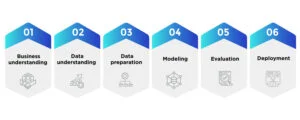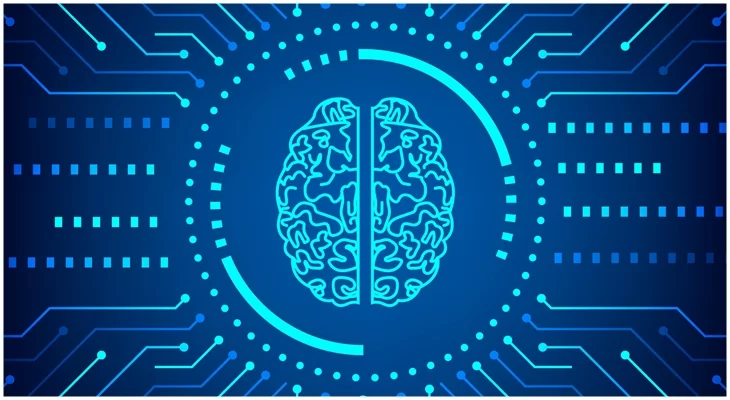CRISP-DM model is a dependable and repetitive process that directs data mining capabilities from conception to implementation.
It assures a systematic approach, enhancing the impact and productivity of the procedure. This strategy is well known for its capacity to provide applicable and precious insights. For which it coordinates data mining activities with business objectives.
This blog discusses the meaning, steps, importance, and characteristics of the CRISP-DM model. Let's get started!
What is the CRISP-DM Model?
CRISP-DM is an abbreviation of the Cross-Industry Standard Process for Data Mining. This process is cyclic. The CRISP-DM model offers a structured way to plan, organize, and implement a data mining project.
It is a robust and validated procedure. It has below six steps:
- Business understanding
- Data understanding
- Data preparation
- Modeling
- Evaluation
- Deployment
Thorough Description of 6 Steps in the CRISP-DM Model
1. Business understanding
It is an initial phase. Its focus is to understand the goal and requirements of the project from a business point of view.
Essential tasks in business understanding include:
- Describing business goals
- Evaluating the ongoing present situation
- Deciding data mining aims
- Constructing a project plan
2. Data understanding
In this stage of the CRISP-DM model, data scientists start the primary data collection and familiarize themselves with the data.
Essential tasks in data understanding include:
- Assembling primary data
- Interpreting data
- Inspecting data
- Checking data quality
3. Data preparation
Data is occasionally clean; otherwise, we always need to clean it. So, in this stage, data scientists devotionally clean the data and then transform raw data into the acceptable format required for modeling.
Essential tasks in data preparation include:
- Choosing data
- Cleaning data
- Constructing data
- Combining data
- Arranging data
4. Modeling
Once clean data is ready, different modeling techniques are applied to that clean data. Each method requires different data formats.
Essential tasks in modeling include:
- Choosing modeling techniques
- Crafting tests
- Constructing the model
- Testing the model
5. Evaluation
In this stage of the CRISP-DM model, the overall performing capacity of the designed model is evaluated. In the first stage, some business goals are decided. This stage ensures that those goals are fulfilled.
Essential tasks in the evaluation include:
- Analyzing results
- Reviewing the process
- Deciding the following required steps
6. Deployment
This is the last stage of the CRISP-DM model. In this stage, deployment of the model into a real-world environment takes place. This stage will be either simple or complicated. If it is simple, then one has to only establish a report. However, if it gets tricky, then the implementation of a repeated data mining process is required.
Essential tasks in deployment include:
- Organizing deployment
- Observing and maintenance
- Reviewing the project
- Finalizing the project
Importance of CRISP-DM Model
1. Directs efforts at data mining
CRISP-DM model is an established technique that presents an overview of the data mining life cycle. It serves as a light for those engaged in data mining.
2. Helps concentrate on key elements
CRISP-DM may assist in guaranteeing that objectives, questions, data, techniques, and outcomes are matched.
3. Provides a road map for achievement
The systematic approach to project planning, execution, and evaluation offered by CRISP-DM offers a clear road map to success.
4. Improves one's ability to analyze data
Data analysis procedures may be better structured and arranged with the use of CRISP-DM, becoming more lucid, accurate, and repeatable.
5. Helps one learn from experience
Based on assessment and feedback, CRISP-DM can assist in reviewing and improving procedures, models, and results.
6. Ensures that tasks are simple
Projects may be made to be clear-cut, skillfully completed, and well-documented with the use of CRISP-DM.
Characteristics of the CRISP-DM Methodology
- Pay attention to business objectives
Data miners are encouraged by CRISP-DM to concentrate on business objectives to ensure that the project's results bring real advantages to the company.
- Iterative methodology
CRISP-DM offers regular chances to assess a project's advancement towards its initial goals.
- Technology and neutrality
CRISP-DM provides a framework that can be applied to any data mining issue and utilized with any program.
Wrapping Up!
The CRISP-DM model's systematic approach to data mining makes it extremely useful. In addition to helping in the completion of corporate goals, it also enhances the general caliber and dependability of data analysis.
Organizations may guarantee the effectiveness and impact of their data mining initiatives by being dependent on its six steps: business understanding, data understanding, data preparation, modeling, evaluation, and deployment.
This blog content will help you to get detailed knowledge about the CRISP-DM model. For more tech-related, helpful, and insightful content, keep visiting us at KnowledgeNile.
You May Also Like to Read: Top 11 Data Mining Techniques






